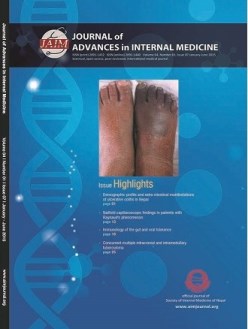Nailfold capillaroscopic findings in patients with Raynaud’s phenomenon: Preliminary report
DOI:
https://doi.org/10.3126/jaim.v4i1.14175Keywords:
capillaroscopy, raynaud phenomenon, sclerodermaAbstract
Back grounds and Aims: Microvascular involvement of nailfold often occurs in systemic rheumatic diseases, especially scleroderma and related conditions. Nailfold capillaroscopy is easily performed non-invasive, simple, repeatable, sensitive, safe and inexpensive method to examine nailfold architecture by microscope.The normal capillaries are thin, symmetrical and have hair-pin appearance. Anomalies include dilated capillary loops, dropouts, tortuosity, avascular area, arborifications, megacapillaries, infracts,thrombsis and haemorrhages. This study aims to see the morphological changes in microcirculation in nailfolds of patients with Raynaud’s, which can be helpful in predicting the presence of connective tissue disorder.
Methods: It is an observational study conducted at National Center for Rheumatic Diseases, Kathmandu from 26th March 2014 to 30th March 2015. Nailfolds of 8 fingers of both hands in 105 patients were examined using a hand held microscope.
Results: Of 105 patients, 91 patients (86.6%) had abnormal morphological changes while 14 (13.4%) had no significant changes in microvessels. Normal patients had no underlying connective tissue disease(CTD) but those with abnormal findings had proven underlying CTD which included Lupus 6.5%, Scleroderma 17.5%, Rheumatoid Arthritis 14.2%, Mixed CTD7.6%, Undifferentiated CTD1.0%, Undifferentiated inflammatory arthritis 14.2%, Psorasis 1.0%, Rheumatoid Arthritis with scleroderma overlap 4.3%. No primary diagnosis was found in 32.9% of patients.
Conclusion: Nailfold capillaroscopy allows direct examination of microvascular structure of a patient. Abnormal findings in a patient with Raynaud’s phenomenon might help to identify the presence of or future evolution into systemic connective tissue disorder.
Journal of Advances in Internal Medicine 2015;04(01):13-15
Downloads
Downloads
Published
How to Cite
Issue
Section
License
This license enables reusers to distribute, remix, adapt, and build upon the material in any medium or format, so long as attribution is given to the creator.




